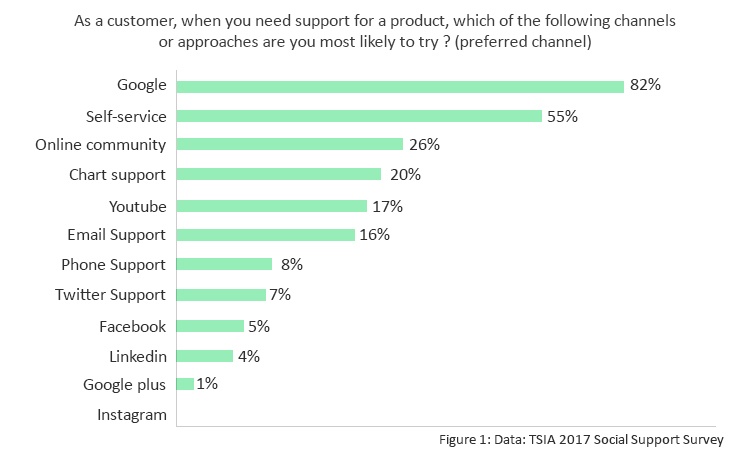The customer experience is becoming the most critical differentiator among competitors. Customers evaluate purchases as much or more on value and service as on price.
B2B customers want fast responses to their questions and concerns. If they don’t get it, they will at the least be open to alternatives. If they have a terrible experience, they are apt to share their experiences on social media.
What’s more, you are not competing only with businesses in your niche. Your customers will compare your customer experience with the service they receive from every other product or service provider. If you sell construction equipment, they could compare your service with what they receive from an online shoe seller.
Customer self-service has emerged as the preferred solution for customer expectations, delivered through an online portal. Gone are the days when a customer with a problem picked up the phone to get a resolution to a problem. A customer who needs help is eight times more likely to search Google and five times more likely to use a company’s self-service customer portal than to make a phone call (See Figure 1)
Online Customer Portals Reduce Cost
Faster service is not the only reason to maintain a useful and engaging customer portal. It can have a lot of impact on costs and revenue.
- Cost of resolving issues using telephone support averages over four times much as customer self-service.
- For companies whose products and services require training, an integrated learning center can mitigate or offset the costs of providing training. In many industries, training and certifications are a substantial revenue generator.
Online Portals Consolidate Information Services
A well-designed customer portal is much more than support. It can be the central repository and gateway to everything a customer needs – knowledge management, CRM, an online community, and in-depth training. You can create a community discussion for sharing ways to get more value from your services and products.
With a unified look and feel, your customer portal and its components can become an active advocate for your brand and create a strong message that your customers are the core of your business.
However, that will not happen without a common purpose across the organization in creating an excellent customer experience.
Who Owns the Customer Experience?
One of the most influential arguments we can make for complete, unified customer website is that it can create the opportunity for you to build an organization-wide and comprehensive picture of your customer.
In many organizations, a fragmented view of the customer experience (CX) is the rule. Sales think they are the primary drivers of the customer experience. Customer Success may or may not believe they own it. Only 9% of marketers think they lead it.
Last year, the CMO Council reported that only 14% of sales and 12% of marketing professionals rate their ability to deliver customer service as exceptional.
It’s easy to say everyone in the company owns the customer experience, but you know how that goes – when everyone is responsible, no one is responsible. Sales think CX is gaining a new customer. Marketing thinks it is a string of campaigns. Customer Success believes CX equals resolved issues. Each of them is both right and terribly wrong. Your organization needs a customer experience champion, and a unified view of the entire customer experience from the first contact to the advocates who answer questions in your customer community.
Integrate the Customer Experience
We recommend making the data your customer portal and it associated components integral to the comprehensive view of your customer and mine the data it produces to both improve the experience and inform your CRM.
- A knowledge management platform is an essential component of the customer portal. Use it to capture customer actions as they search for manuals, guides, and problem solutions. Keep your content current and do a continuous gap analysis to know what they are seeking.
- Integrate your CRM with your portal and make customer interactions available to marketing and sales. Detailed customer history can be a powerful conversation starter when it is time for subscription or contract renewals.
- If your service or product is technology-based, keep customer success and sales aware of updates, upgrades, or enhancements the customer has not implemented.
- Go beyond providing a tool for customer suggestions. Mine support data and the customer community for feature requests and keywords like “I wish they would…”
- Of course, your customer learning system Integrate must be accessible from your portal home page and anywhere else your customer seeks knowledge, but also send data from your LMS to inform your CRM what training the customer has or has not completed.
- Don’t skimp on your search engine. Go beyond basic keyword search to an AI-driven search capability that can index your support and knowledge resources. The search history will be an intelligent data source for product development in addition to helping you improve the customer experience.
- Consider using a chatbot or textbot to assist user searches. Anything you can do to remove friction between the user and the support and information they need will pay off in customer loyalty.
This is not an exhaustive list, but it may help you think about how the components of your customer experience should talk to each other. We hope you can take advantage of the opportunities that a unified customer view will provide.
Chasma Place, is an independent source for solutions that will help you keep pace with changes in the way your people work without ripping and replacing your existing system.